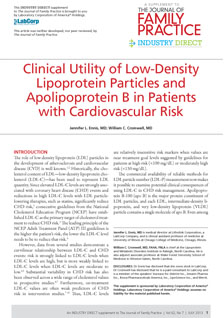Because of biological variability in lipid metabolism and the effects of lipid-lowering therapies, the cholesterol content carried in LDL particles varies greatly among patients and in the same patient over time. When measures of LDL-P quantity differ from LDL-C in terms of percentiles, apo B or NMR-measured LDL-P consistently demonstrate a significantly stronger association with CHD outcomes than LDL-C in prospective epidemiologic studies and better predict on-treatment residual risk in clinical trials.

Medical Education Library
Clinical Utility of Low-Density Lipoprotein Particles and Apolipoprotein B in Patients with Cardiovascular Risk
J Fam Pract. 2013 July;62(7):S1-S8
This INDUSTRY DIRECT supplement to The Journal of Family Practice is brought to you by Laboratory Corporation of America® Holdings.

